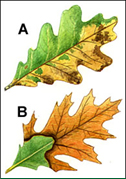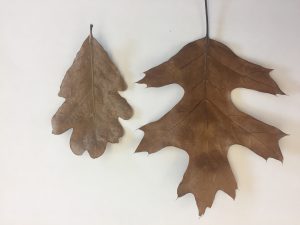It’s more important than ever to know what oak you’re looking at because of the introduction of oak wilt to Long Island, which is a serious disease that affects all species of oaks (Quercus spp.). While all species of oaks are susceptible to oak wilt, the fungal pathogen (Ceratocystis fagacearum) doesn’t impact all oak species equally to the same degree. Species in the red oak group, in particular red oak (Quercus rubra), are most devastated by this disease and die within the first year or less upon infection. With species in the white oak group, however, a much slower progression of the disease occurs—it may be years before the infected tree dies. To learn more follow this link to Oak Wilt Risk: Distinguishing Red and White Oaks.
Tag Archives: red oaks
Prune Your Oak Trees in Winter
In an earlier post we discussed oak wilt, which was identified for the first time on Long Island this summer in the Town of Islip. Unfortunately, additional reports of oak wilt have since occurred from several other towns in Suffolk County. In light of these reports, the DEC is urging homeowners to prune their oak trees in winter and not during the growing season. One way that oak wilt spreads is through insects (sap beetles are one of the main culprits), which can move the fungus from an infected tree to a healthy tree. During the warmer growing season sap beetles are active and attracted to the fresh wounds, increasing the chances of disease spread.
Learn more about oak wilt on the DEC website.
Oak Wilt Disease Spotted on Long Island
Earlier this month, the NY State Dept. of Environmental Conservation issued a press release about the first known case of oak wilt, a serious tree disease, on Long Island. In June an arborist spotted symptoms of the disease in four trees in the Town of Islip and submitted samples from them to the Cornell Plant Disease Diagnostic Clinic, where the disease was identified. No treatment for oak wilt is known to contain and kill it other than removing infected trees and surrounding host oak trees, which was done in Islip. This is the second place in New York where the disease has been seen, the first being in Schenectady County in 2008 and 2013.

Note different patterns of infection on the white oak leaf (A), with its round lobes, and the red oak (B), with its pointy lobes.
Oak wilt appeared in the Great Lakes Region in 1944 and has since spread throughout the eastern United States, killing thousands of oak trees each year. Caused by the fungus Ceratocystis fagacearum, the disease creates blockage in the xylem vessels (sapwood) that conduct water within trees, slowing water delivery until leaves wilt and drop off. Red oaks succumb more quickly to the disease than white oaks and typically die within a few weeks of infection.
Oak wilt spreads three ways:
- through underground root systems
- through beetles that colonize infected oak trees and carry oak wilt to other trees
- through the movement of firewood within and out of areas where trees are infected
If you witness unusual leaf wilting and drop off on oak trees where you live, please call the NYSDEC Forest Health Information Line toll-free at 1-866-640-0652 to report it.
To learn more about the symptoms of oak wilt and how to submit samples of oak trees suspected of having it, click here to visit the 2016 Oak Wilt Update on the Cornell Plant Disease Diagnostic Clinic website. This You-tube video Oak Wilt in NY (made by Dr. George Hudler in 2008 after the first outbreak of oak wilt upstate) is very helpful in walking you through how to identify red and white oaks and how to prepare plant samples to submit for diagnostic testing.
Robin Simmen is Community Horticulture Specialist for CCE Suffolk. She can be reached at rls63@cornell.edu or at 631-727-7850 x215.

